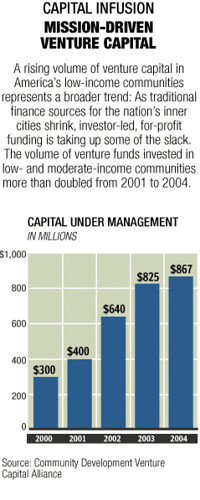Promoting the development of businesses in the inner cities
I talk about this issue all the time, and how in my opinion, particularly in the retail end, we don't do a very good job in Washington, DC in nurturing the development of small businesses. This is complicated by the fact that most of the retail attraction programs that the city offers focus on large chains.
This series in the Milwaukee Journal-Sentinel, slugged "Urbanomics: Local Ventures--Global Visions" answers some of the questions that people ask me. You need focused training, and yes, some money, but you also need to be able to work with micro-entrepreneurs that will need some time before they can qualify for traditional loan products. (In DC, the Latino Economic Development Corporation does do some of this kind of work, and DC's Dept. of Housing and Community Development has supported this program for quite awhile.) Also see "Editorial: 'Urbanomics' and the city."
 Milwaukee Journal-Sentinel graphic by Enrique Rodriguez.
Milwaukee Journal-Sentinel graphic by Enrique Rodriguez.From the editorial:
• Milwaukee's share of federal Community Development Block Grants has fallen by $3.4 million in the last five years, and President Bush's 2006 budget calls for 31% in reductions nationally to the program.
• The U.S. Small Business Administration has had its lending appropriations cut by more than half since 2001.
• "Minorities will represent 100 percent of the growth in the work force in the next 20-plus years," said Mike Bolger, a demographics researcher at the Asaba Group Inc. in Massachusetts. And finally:
• Minorities substantially lag whites so much in education and employment levels that many are arguably unprepared to compete in an increasingly global and knowledge-based economy.
Let us connect the dots.
If the traditional method of spurring development in urban areas - federal dollars - is drying up, then Milwaukee must increasingly look more to private solutions to spur entrepreneurship and job growth where they are needed most, in the inner city. That's right. Government - and taxes - cannot solve all problems, though they will continue to play a vital role.
_________
Unlike traditional industrial cities like Milwaukee, DC doesn't have an industrial tradition, other than construction, transportation (getting people to and from the city), and serving the residents (food distribution, etc.).
At the same time, because of the federal presence it is clear that the region is steeped in technology, particularly telecommunications, biosciences, and computing. There is nothing to prevent the city from focusing additional attention on what I think of as urban industries: construction; transit and transportation; and energy efficiency.
A couple months ago, Black Enterprise magazine announced its lists of what they call the Top 100s Black-owned businesses. I was disappointed to see that no DC-based businesses made the list, although Baltimore was represented.
I thought then that in setting objectives and numbers for success in the economic development cluster of the city government, that having DC-based businesses make lists such as this, or the Inc Magazine Inner City 100 list of the fastest growing inner-city based businesses.



0 Comments:
Post a Comment
<< Home